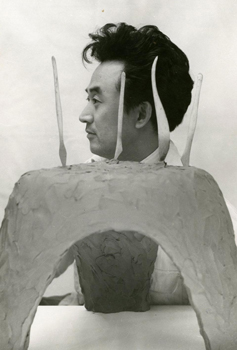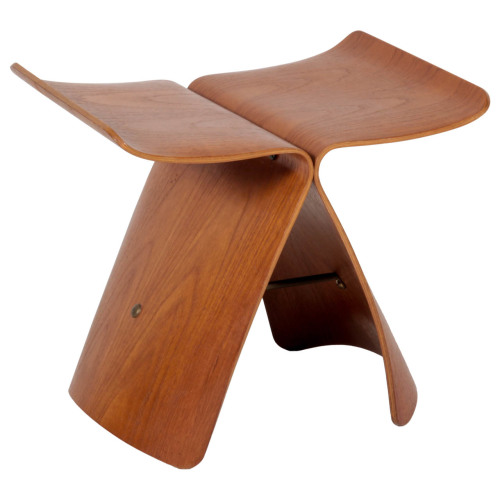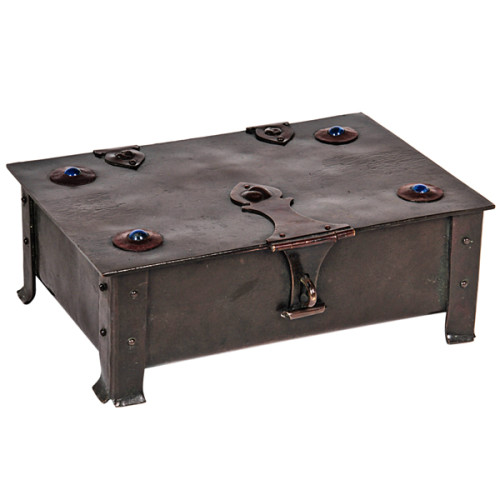

Sori Yanagi / Tendo Co. Ltd. / Japanese Crafts “Butterfly” Stool c.1956
Sori Yanagi (1915-2012), Japan
Tendo Co. Ltd., Japan
Butterfly stool, 1956.
Bleached rosewood veneer on plywood with brass.
H: 15” x W: 16 ½” x D: 12”
Price: $4,900
This model can be found in the collections of the Museum of Modern Art and the Metropolitan Museum in New York.
The Japanese designer Sori Yanagi is best known for his 1956 Butterfly Stool. It is both elegant and utterly simple: two curved pieces of molded plywood are held together through compression and tension by a single brass rod. The stool’s graceful shape recalls a butterfly’s wings, and has also been compared to the form of torii, the traditional Shinto shrine gates. He loved traditional Japanese crafts and was dedicated to the modernist principles of simplicity, practicality and tactility that are associated with Alvar Aalto, Charles and Ray Eames, and Le Corbusier.”
Yanagi, who studied architecture and art at Tokyo’s Academy of Fine Art, was inspired by the work of Le Corbusier and by the designer Charlotte Perriand, with whom he worked in the early 1940s, while she was in Tokyo as the arts and crafts adviser to the Japanese Board of Trade. But perhaps the most indelible influence on Yanagi was that of his father, Soetsu Yanagi, who led the “mingei” movement, which celebrated Japanese folk craft and the beauty of everyday objects, and who founded the Nihon Mingeikan (or Japanese Folk Crafts Museum) in Tokyo. Yanagi fils, who was named director of the museum in 1977, succinctly described his design aesthetic in a 2002 interview in The Japan Times: “I try to create things that we human beings feel are useful in our daily lives. During the process, beauty is born naturally.” Throughout his life, Sori Yanagi was inspired by what he called “anonymous design” — he cited the Jeep and a baseball glove as two examples — and he in turn inspired younger designers, like Naoto Fukasawa, Tom Dixon and Jasper Morrison.
Related Products
-
Josef Hoffmann / Wiener Werkstaette Leather purse c. 1909-10
JOSEF HOFFMANN (1870 – 1956) Austria
WIENER WERKSTÄTTE (1903-1932) Vienna
Leather clutch purse c. 1909-10
Leather clutch with gilt tooling and silk lining, gilt bronze clasp
Marks: WIENER/ WERK/ STÄTTE ٭ (inside flap)
Similar design illustrated: Wiener Werkstätte Lederobjekte (Vienna: Museum für angewandte Kunst, 1992) p. 45
Related models illustrated: Vienne 1880-1938: l’Apocalypse Joyeuse (Jean Clair, Editions du Centre Pompidou: Paris, 1986), p. 280; Vienna: Dream and Reality, ed. Hans Hollein & Catherine Cooke (London: Architectural Design Editions, Ltd., 1986) p.38
W: 8 3/4“ x H: 6” -
Albert Edward Jones British Arts & Crafts Copper and Lapis Lazuli Box c.1905
Albert Edward Jones (1879-1954) Birmingham, UK
British Arts & Crafts MovementFooted box with hinged lid and hasp 1905
Hand wrought and patinated copper with riveted strap work and hasp, inset with 4 cabochons of lapis lazuli, brown leather and wood interior.
This box is a particularly handsome example of British arts & crafts metalwork by the famous designer / craftsman A.E. Jones. It retains its original deep, rich chocolate brown patina with the contrasting cobalt blue large round bezel-set cabochons of lapis lazuli.
H: 2 1/2″ x D: 4 3/4″ x W: 6 1/2″









